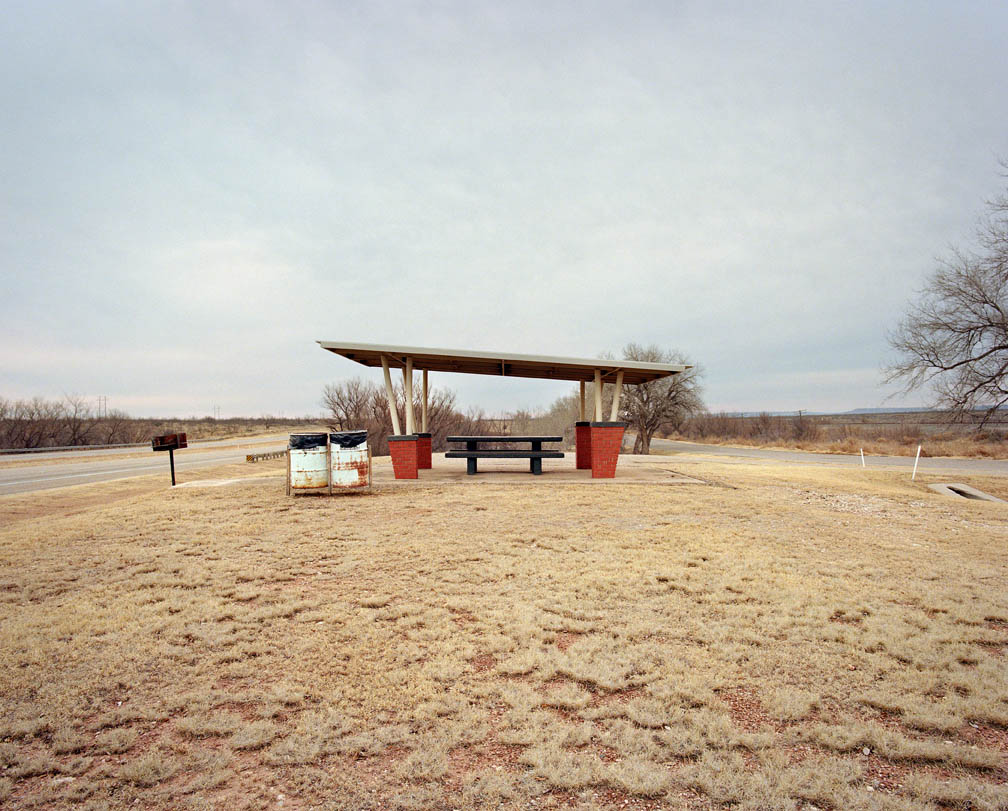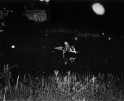Ryann Ford: The Last Stop
Photographer Ryann Ford was simply taking the scenic Route 66 road trip in 2007 while moving to Austin when her next series, The Last Stop, presented itself. All long the route she noticed the array of humble and quirky rest stops that reflected a host of architectural expressions – mock adobe dwellings in New Mexico, Depression-era stone houses in Arizona, faux oil rigs in Texas. For close to seven years, Ryan captured over 150 rest stops and pondered the future of these structures. Fortunately, Powerhouse has just released the rich monograph, The Last Stop, which captures their moment in time, as a number of these rest stops have already disappeared. On Thursday, June 23, 2016, Ryann will have a book signing at Mockingbird Domestics in Austin, TX.
Raised in a Southern California mountain town so small it didn’t even have a stoplight; Ryann Ford had the freedom to explore and observe from a young age. At age 12, she took her first photo using her father’s old Pentax Spotmatic from Vietnam; at age 18 she enrolled at the renowned Brooks Institute of Photography in Santa Barbara, where she earned her Bachelor of Arts degree in Photography. Living in Los Angeles, Ford began to focus her creative work in two areas: artifacts of the abandoned American desert, and the fading landscape of California’s Salton Sea. Her work has been been featured in such publications as the New York Times Magazine, The Wall Street Journal, The Atlantic, and NPR. Ford is currently a commercial photographer who regularly shoots for such clients as Better Homes and Gardens, The New York Times, and Texas Monthly. Her meticulously composed architectural and interior photography has become an industry favorite, and it is this style—clean and thoughtful—that continues to inform her fine art today.

©Ryann Ford, Abiquiu, New Mexico – U.S. 84 Near Abiquiu, New Mexico – U.S. 84 – I was driving back to Texas, after being in Colorado for Christmas, when I passed this stop. We were the first ones to stop there since snow had fallen overnight.
The Last Stop
It was the summer of 2007 when I made the move from Southern California to Austin, Texas. Not long after I arrived, I started to accept photography assignments, some of which took me all over Texas. On the way to a shoot I usually would be in a hurry and took the interstates, but on the way home, after the stress retreated, I drove the back roads and lesser-traveled highways for a change of scenery.
It was sometime in my first two years in Texas that I started noticing rest stops. I glimpsed one and thought, “That would be a great photo.” I was drawn to the minimalist scene—a modest little structure set out on a beautiful landscape—and the mid-century architecture.
I remember getting home from an assignment one day, sitting down at my computer to start retouching, and being distracted by the thought of photographing the vintage rest stops I had just seen.

©Ryann Ford, Austin, Nevada – U.S. 50, from The Last Stop: Vanishing Rest Stops of the American Roadside, published by powerHouse Books.
Procrastinating on my retouching work, I Googled to see if anyone already had photographed rest stops and also to see what other stops out there looked like. Instead, I was met with news article after news article detailing the demise of rest stops all over the country. That was during the worst of the recession, and states were cutting expenses wherever they could. Highway rest stops were the first to go. Some were just closed temporarily but others were demolished. I scrolled to an article about Texas, clicked the link, and saw a photo of a rest stop whose roofline took the shape of longhorns. A huge Texas flag was painted down the walls of the structure. It was an amazing example of Americana. To my horror, the article detailed how the rest stop was “a breeding ground for crime” and was slated for demolition. I was in disbelief.

©Ryann Ford, Flower Mound, Texas – I 35 – This was the rest stop that inspired the project. As I researched rest stops to see what was beyond the Austin area, I was excited to find a photo of this rest stop, and then shocked to read it would soon be demolished. The next weekend I drove four hours north to shoot it, and sure enough, it was demolished a few weeks later. From The Last Stop: Vanishing Rest Stops of the American Roadside, published by powerHouse Books.
That next weekend I jumped in the car and made the four-hour drive to Flower Mound, near Fort Worth. The rest stop was even more kitschy in person. I got a great shot and headed home. A few weeks later I was back in the area on assignment, and sure enough, it was gone. A big orange barricade blocked the entrance ramp, the concrete structures had been knocked down and hauled away, and the ground where they stood for decades was smoothed over as if they had never existed. I immediately felt an urgency to shoot as many rest stops as I could before they all were gone forever. My hope is that this book cultivates an interest in the often-overlooked beauty and significance of rest stops in the American travel experience.

©Ryann Ford, Bonneville Salt Flats – Wendover, Utah – This was another favorite to shoot. Since beginning the project years ago, this had been at the top of my list to shoot. Once I found out that the book was a go, I made a special trip to Utah just to shoot this stop. The salt flats were magical. This has got to be one of the most incredible places in the country.From The Last Stop: Vanishing Rest Stops of the American Roadside, published by powerHouse Books.

©Ryann Ford, Clines Corners, New Mexico – I 40/Route 66, From The Last Stop: Vanishing Rest Stops of the American Roadside, published by powerHouse Books.

©Ryann Ford, Galveston, Texas, From The Last Stop: Vanishing Rest Stops of the American Roadside, published by powerHouse Books.

©Ryann Ford, Near Justiceburg, Texas – U.S. 84 – I was driving to Colorado from Texas and stopped at sunrise to get this photo. It was the middle of winter and below freezing. There wasn’t a soul around.From The Last Stop: Vanishing Rest Stops of the American Roadside, published by powerHouse Books.

©Ryann Ford, Near Lajitas, Texas – FM 170 – This is one of the most remote rest areas in the country. These teepees are hidden just outside Big Bend National Park, right on the Rio Grande, which divides the United States and Mexico. As we were shooting, a pack of Javelinas ran by.From The Last Stop: Vanishing Rest Stops of the American Roadside, published by powerHouse Books.

©Ryann Ford, Las Cruces, New Mexico – I 10, From The Last Stop: Vanishing Rest Stops of the American Roadside, published by powerHouse Books.

©Ryann Ford, Monument Valley, Arizona – This is one of the last picnic tables in Monument Valley. There were many more, but the rest were demolished so that a hotel overlooking the valley could be built. This table is located in a pull-off, offering a great view of “The Mittens” rock formations in the background, From The Last Stop: Vanishing Rest Stops of the American Roadside, published by powerHouse Books.

©Ryann Ford, Sonora, Texas – I-10, From The Last Stop: Vanishing Rest Stops of the American Roadside, published by powerHouse Books.

©Ryann Ford, Near Thackerville, Oklahoma – I-35 – This stop was closed and fenced off, but we found a farm road just past the rest area that took us around back. It looked like it had been closed for years; some of the giant oaks had fallen on a few of the teepees, and it was winter, so the trees were bare. From The Last Stop: Vanishing Rest Stops of the American Roadside, published by powerHouse Books.

©Ryann Ford, Walker Lake, Nevada – U.S. 95 – Shortly after arriving here, we started noticing an unusual prevalence of very large spiders. Actually, they were everywhere. It was so strange and creepy that we Googled it, and sure enough, news articles detailed the freakish “spider infestation.” From The Last Stop: Vanishing Rest Stops of the American Roadside, published by powerHouse Books.

©Ryann Ford, White Sands National Monument, New Mexico – This is by far my favorite location. The picnic tables there are iconic, straight out of the ’60s, and the landscape is like no place else on earth. It was a hot summer day at sunset when we were shooting, and a thunderstorm had just rolled through, so hardly anyone was around. You couldn’t take a bad picture in this place. From The Last Stop: Vanishing Rest Stops of the American Roadside, published by powerHouse Books.
Posts on Lenscratch may not be reproduced without the permission of the Lenscratch staff and the photographer.
Recommended
-
ALEXIS MARTINO: The Collapsing Panorama April 4th, 2024
-
The International Women in Photo Association Awards: Lorraine Turci: The Resilience of the CrowMarch 16th, 2024
-
Julie Rae Powers: Deep RutsMarch 2nd, 2024
-
Interview with Peah Guilmoth: The Search for Beauty and EscapeFebruary 23rd, 2024
-
Interview with Kate Greene: Photographing What Is UnseenFebruary 20th, 2024






























































